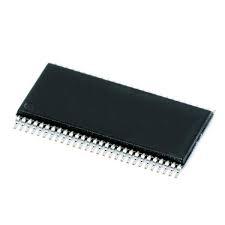SN65LVDS93ADGGR
Part Number: SN65LVDS93ADGGR
Manufacturer: Texas Instruments
Description: IC TX LVDS SERDES 56TSSO
Shipped from: Shenzhen/HK Warehouse
Stock Available: Check with us
ICRFQ.com - Electronic Components Distributor in China Since 2003

Part Number: SN65LVDS93ADGGR
Manufacturer: Texas Instruments
Description: IC TX LVDS SERDES 56TSSO
Shipped from: Shenzhen/HK Warehouse
Stock Available: Check with us
| Datasheet | |
|---|---|
| Category | Integrated Circuits (ICs) |
| Family | Interface – Serializers, Deserializers |
| Manufacturer | Texas Instruments |
| Series | – |
| Packaging | Tape & Reel (TR) |
| Part Status | Active |
| Function | Serializer |
| Data Rate | 3.78Gbps |
| Input Type | LVTTL |
| Output Type | LVDS |
| Number of Inputs | 28 |
| Number of Outputs | 4 |
| Voltage – Supply | 3 V ~ 3.6 V |
| Operating Temperature | -40°C ~ 85°C (TA) |
| Mounting Type | Surface Mount |
| Package / Case | 56-TFSOP (0.240″, 6.10mm Width) |
| Supplier Device Package | 56-TSSOP |
The SN65LVDS93ADGGR is a high-speed serializer IC that can send data reliably in a number of different situations. Its amazing features, like a data rate of 3.78 Gbps, 28 input channels, 4 output channels, and a 56-TSSOP package, have made it popular in industries that need to send and receive data quickly and efficiently. In this guide, we’ll look at the most important parts of the SN65LVDS93ADGGR, how it works, and what it could be used for.
The SN65LVDS93ADGGR is a high-speed serializer integrated circuit (IC) that makes it possible to send data quickly and reliably in many different situations. As a serializer, its main job is to turn parallel data into a serialized bitstream. This makes data movement over a single differential signal pair more efficient.
The SN65LVDS93ADGGR was made to handle high-speed data rates, and it can do that up to a maximum of 3.78 Gbps. This makes it good for apps that need to send data quickly, like video interfaces, display systems, and electronics in cars.
One of the most important things about the SN65LVDS93ADGGR is that it has 28 input lines that allow data to be sent in parallel. Because of this, it can be used with systems that need to send various data streams at the same time.
The SN65LVDS93ADGGR also has four output lines that send the serialized data. Differential pairs of these output channels use Low-Voltage Differential Signaling (LVDS) technology to send data quickly and without noise.
The IC comes in a 56-TSSOP (Thin Shrink Small Outline Box), which is a small box that makes it easy to put on circuit boards.
Overall, the SN65LVDS93ADGGR is a reliable and efficient way to serialize high-speed data, making it possible to send data securely in many different situations. It has a high data rate, multiple input lines, and LVDS technology, which make it a flexible choice for systems that need to send and receive data quickly and reliably.
These features make the SN65LVDS93ADGGR a versatile and reliable choice for high-speed data serialization and transmission in various applications.
The SN65LVDS93ADGGR and other devices efficiently transmit data using the high-speed serial communication technology known as Low-Voltage Differential Signaling (LVDS). LVDS is appropriate for high-speed applications due to a number of its benefits, including:
The LVDS operating principles entail sending data as voltage variations between two lines. A differential voltage is sent out by the transmitter, with one wire carrying the positive voltage (Vp) and the other the negative voltage (Vn). In order to decipher the data, the receiver then measures the voltage difference between Vp and Vn.
In the SN65LVDS93ADGGR, serialized data is transmitted from the parallel input channels to the output channels using LVDS technology. High-speed data transport with lower noise susceptibility is guaranteed by LVDS, allowing for dependable and effective communication.
Applications that call for high-speed data transmission, like video interfaces, display systems, and data lines in automobile electronics, frequently employ LVDS. Long transmission lengths, high data speeds, low power consumption, and noise immunity make it the go-to option for applications where dependable and quick data transfer is essential.
The SN65LVDS93ADGGR can provide robust and effective data transmission by utilizing LVDS technology, making it well-suited for high-speed applications that demand dependable data transfer over long distances.
The SN65LVDS93ADGGR carries out a number of essential tasks to facilitate effective data transmission. Let’s investigate its operational features:
In order to ensure effective data transmission, the SN65LVDS93ADGGR performs data serialization, clock generation, and manages the input and output channels. Due to its functional characteristics, it is a good fit for applications that call for parallel data handling and high-speed data transfer.
The SN65LVDS93ADGGR is an integrated circuit (IC) designed for high-speed serialization. It efficiently converts parallel data into a serialized bitstream, enabling effective data transmission.
The integrated circuit (IC) is widely utilized in applications that necessitate high-speed data transmission. These applications include video interfaces, display systems, automotive electronics, and data links across various industries.
The SN65LVDS93ADGGR is a suitable choice for high-speed data transmission due to the noise immunity, high data rates, low power consumption, and long transmission distances offered by LVDS technology.
In conclusion, the SN65LVDS93ADGGR is a high-performance serializer IC that utilizes LVDS technology for efficient, high-speed data transmission. With its high data rate, multiple input and output channels, and compact packaging, it is well-suited for various applications requiring fast and reliable data serialization.
Adhering to recommended operating conditions and design considerations such as impedance matching and power supply is crucial for optimal performance. The IC finds applications in video interfaces, display systems, automotive electronics, and other fields. You can find this product at ICRFQ, a leading electronic component distributor in China.
WhatsApp us